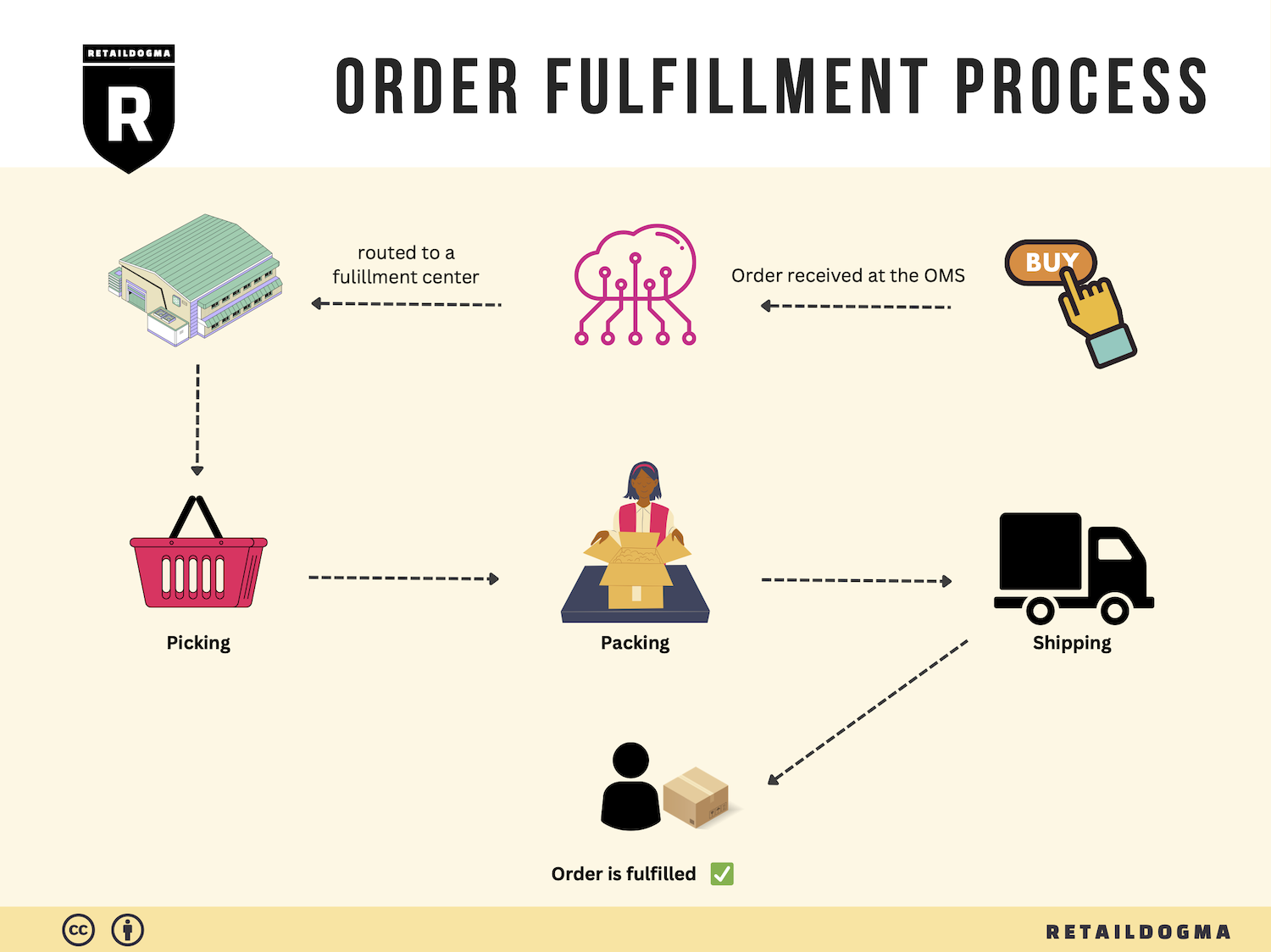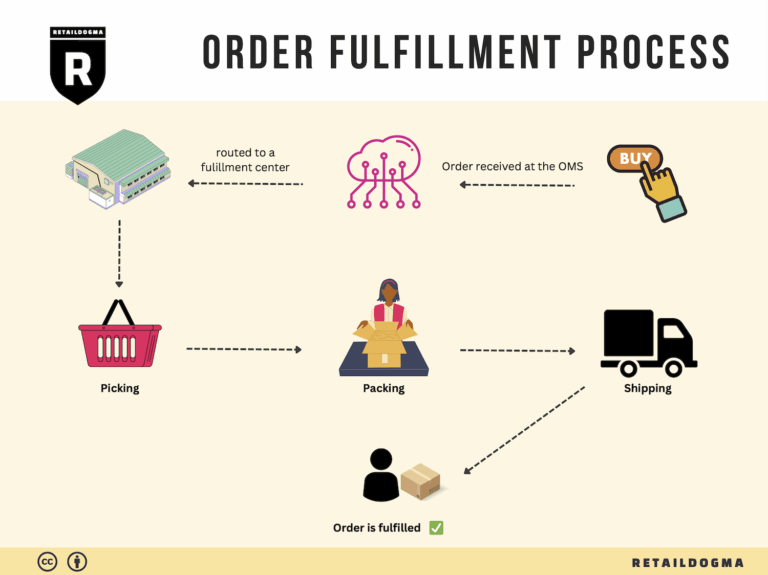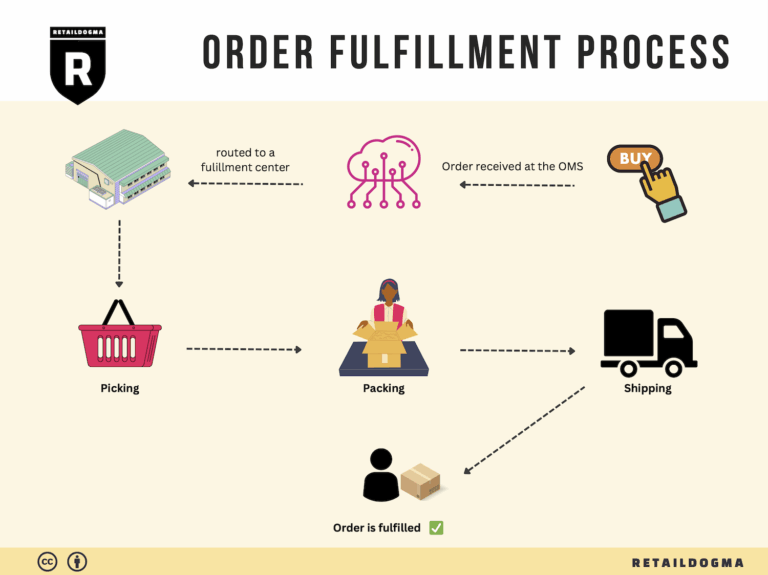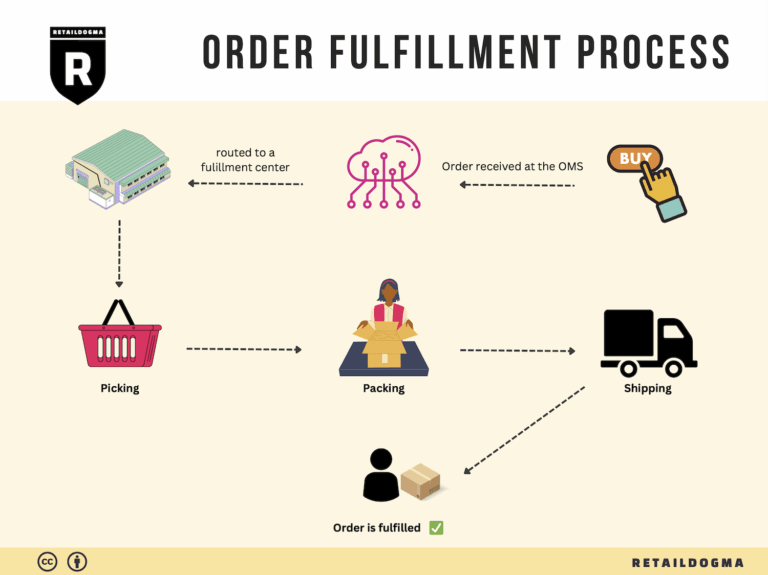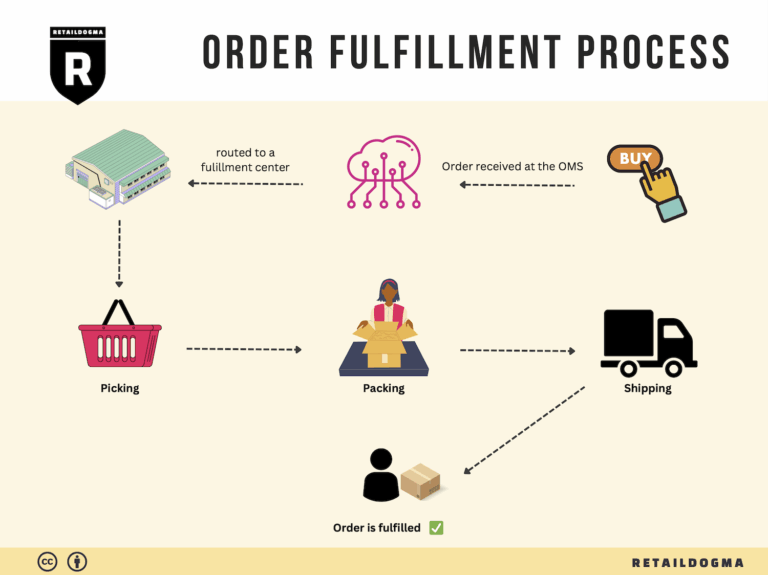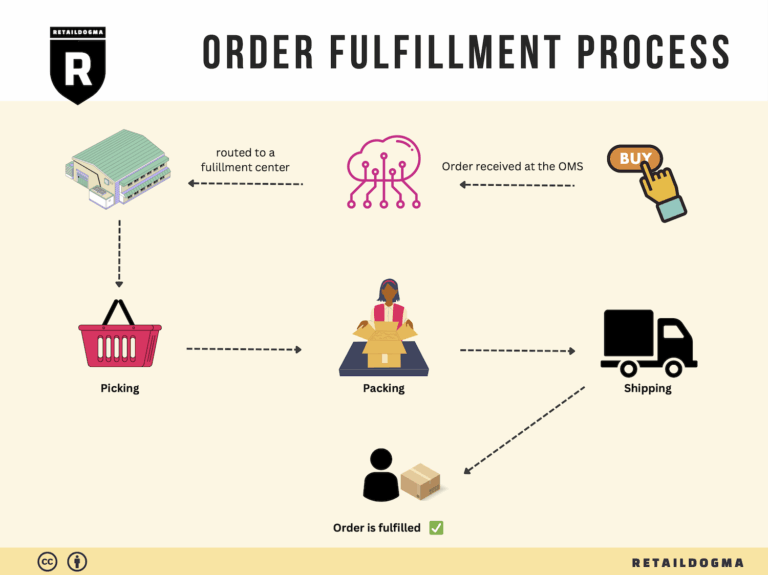What Is A Fulfillment Center? A Complete Guide (2025)
What is E-commerce Fulfillment? An Introduction for Growing Businesses
Understanding E-commerce Fulfillment: A Critical Component for Growth
As e-commerce businesses scale, many owners find themselves grappling with the overwhelming task of packing and shipping orders. The excitement of growing sales can quickly turn into stress when the logistics of fulfillment become unmanageable. This is where a clear understanding of e-commerce fulfillment can make a significant difference. Simply put, fulfillment refers to the entire process of getting a product from a seller to a customer, encompassing inventory management, order processing, packing, shipping, and even returns handling.
In this guide, we will delve into the various fulfillment models available to online retailers, including Third-Party Logistics (3PL) and Fulfillment by Amazon (FBA). Each model comes with its own set of advantages and considerations, making it essential for businesses to evaluate which option aligns best with their operational needs and growth ambitions.
We will also explore the core services that fulfillment centers provide. These services typically include inventory storage, order picking and packing, shipping, and returns management. Understanding these services will help you gauge the capabilities of potential fulfillment partners and ensure they can meet your specific requirements.
Choosing the right fulfillment partner is crucial for your business’s success. We will discuss key factors to consider when evaluating potential partners, such as their technology stack, shipping capabilities, customer service standards, and scalability. These considerations can significantly impact your operational efficiency and customer satisfaction, two critical components of a successful e-commerce business.
Finally, we will touch on the topic of pricing. Fulfillment costs can vary widely based on the model you choose, the services required, and the volume of orders you process. By understanding the pricing structures of different fulfillment options, you can make informed decisions that align with your budget and financial goals.
The goal of this guide is to empower you, the business owner or operations manager, to make smart, strategic decisions about your logistics. By demystifying the fulfillment process and presenting practical insights, we aim to equip you with the knowledge necessary to streamline your operations and enhance your customer experience. Whether you are just starting out or looking to optimize your existing fulfillment strategy, understanding e-commerce fulfillment is a vital step toward sustainable growth.
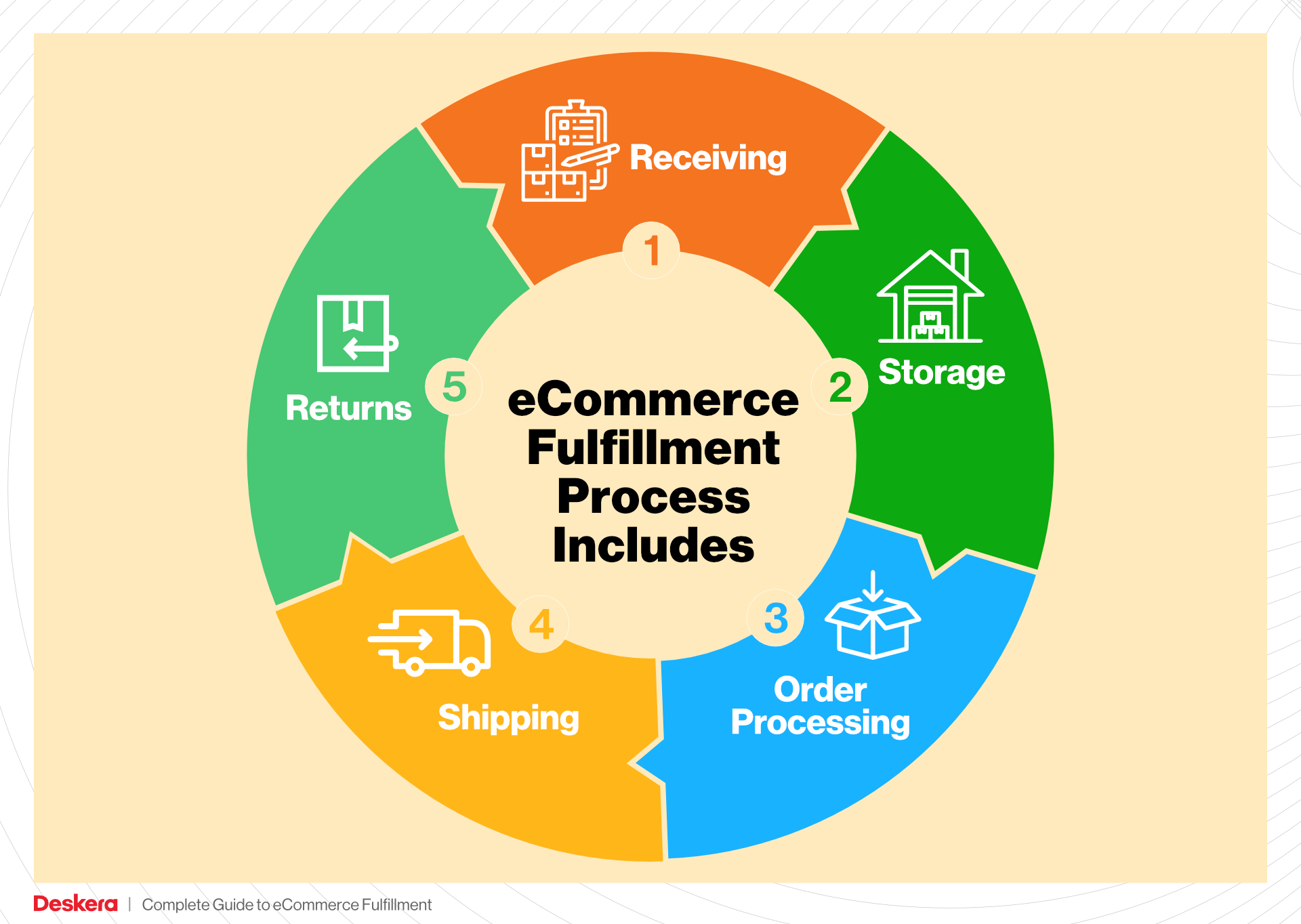
What You’ll Learn In This Guide
- What is E-commerce Fulfillment? An Introduction for Growing Businesses
- The Order Fulfillment Process: From ‘Buy’ Button to Customer’s Door
- Comparing Fulfillment Models: In-House vs. 3PL vs. Dropshipping
- A Deep Dive into Amazon FBA: Pros, Cons, and Who It’s For
- Core Services Offered by Fulfillment Centers
- How to Choose a Fulfillment Partner: A 6-Point Checklist
- Understanding Fulfillment Pricing: A Breakdown of Common Fees
- Frequently Asked Questions (FAQs) about Fulfillment
- Conclusion: Is Outsourcing Fulfillment the Right Move for Your Business?
- Important Disclaimer
The Order Fulfillment Process: From ‘Buy’ Button to Customer’s Door
1. Receiving Inventory
The first step in the order fulfillment process is receiving inventory. When products arrive at the fulfillment center, they undergo a thorough inspection to ensure that the correct items, quantities, and conditions are met. This step is vital because it establishes the foundation for the entire fulfillment process. Accurate inventory receipt prevents stock discrepancies and ensures that the right products are available for customer orders.
Key term: SKU (Stock Keeping Unit) – This unique identifier for each product allows for precise tracking and management of inventory levels. By scanning SKUs upon receipt, businesses can efficiently update their inventory management systems, ensuring that stock levels are accurately reflected.
2. Warehouse Storage
After inventory is received, the next step is warehouse storage. Products are organized in designated areas within the fulfillment center based on their SKUs, sizes, and demand frequency. This strategic placement optimizes space and facilitates easy access to items when orders are placed.
Effective warehouse storage is crucial as it directly impacts picking efficiency. By categorizing products logically, businesses can minimize the time employees spend searching for items, thus speeding up the entire order fulfillment process. Implementing a systematic storage solution, such as zone storage, where items are grouped by category or sales velocity, can significantly enhance operational efficiency.
Key term: FIFO (First In, First Out) – This inventory management method ensures that older stock is sold before newer stock, which is particularly important for perishable goods or items with expiration dates.
3. Order Picking
Once an order is placed, the next critical step is order picking. This involves selecting the correct items from the warehouse to fulfill the customer’s order. Employees or automated systems use pick lists, which detail the items needed for each order, to ensure accuracy during this process.
Order picking is pivotal as it directly influences order accuracy and customer satisfaction. Errors in picking can lead to incorrect shipments, resulting in returns and dissatisfied customers. Utilizing technology, such as RFID (Radio Frequency Identification), can enhance picking accuracy by automating the tracking of items and minimizing human error.

Key term: Pick-to-Order – This method involves picking items only after an order is received, which can help reduce excess inventory and improve cash flow, particularly for e-commerce businesses with diverse product offerings.
4. Order Packing
After the items have been picked, they proceed to the packing stage. This involves carefully packaging the selected products to ensure they arrive safely at the customer’s door. Packaging not only protects the items during transit but also enhances the unboxing experience for customers, which can lead to positive brand perception.
Efficient order packing is essential as it affects shipping costs and delivery times. Using the right packing materials and techniques can minimize damage and optimize space, potentially lowering shipping expenses. Businesses should consider using packing slips, which include order details and return information, to enhance customer communication and streamline any potential returns.
Key term: Dimensional Weight Pricing – This pricing strategy takes into account the size of the package, not just its weight, which emphasizes the importance of efficient packing to reduce shipping costs.
5. Shipping & Delivery
The final step in the fulfillment process is shipping and delivery. Once orders are packed, they are labeled and handed over to logistics partners for transportation. Timely shipping is critical, as customers today expect quick delivery, often within one to two days of placing an order.
The shipping and delivery stage is crucial for customer satisfaction and retention. Businesses can enhance their shipping strategies by offering multiple delivery options, such as standard, expedited, and same-day delivery. Additionally, providing customers with tracking information empowers them to monitor their order status, fostering transparency and trust.
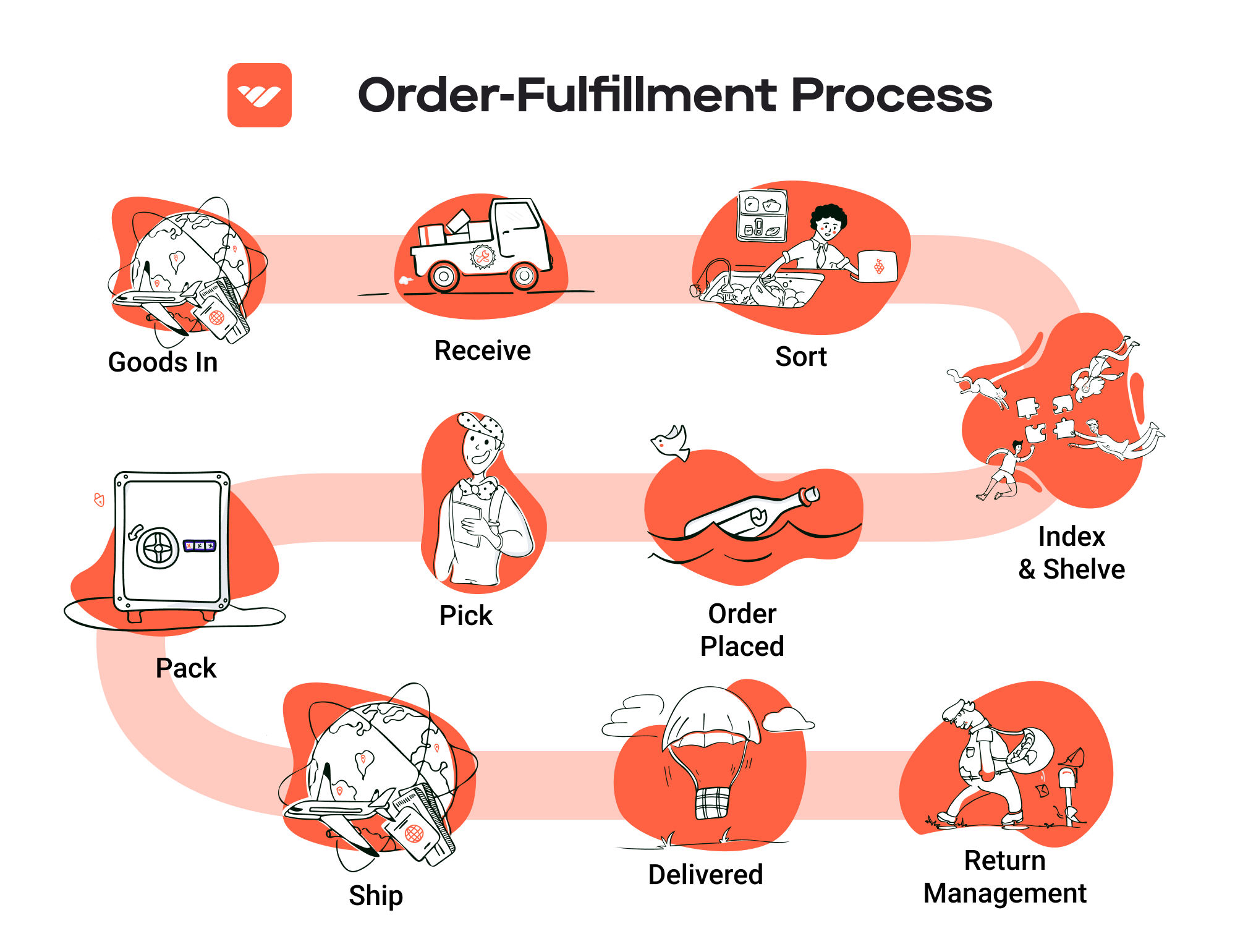
Key term: Last Mile Delivery – This refers to the final step of the delivery process when the package is transported from a distribution center to the customer’s doorstep. Optimizing last-mile delivery can significantly enhance customer experience and reduce shipping costs.
In summary, a streamlined order fulfillment process is vital for e-commerce businesses aiming to scale their operations. By understanding and optimizing each step—from receiving inventory to shipping and delivery—companies can improve efficiency, reduce costs, and ultimately enhance customer satisfaction.
Comparing Fulfillment Models: In-House vs. 3PL vs. Dropshipping
Fulfillment Model Comparison
| Model | Who Handles Inventory | Best For (Business Stage) | Key Advantage | Key Disadvantage |
|---|---|---|---|---|
| In-House Fulfillment | Business itself | Established businesses | Full control over inventory and operations | High overhead costs and resource-intensive |
| Third-Party Logistics (3PL) | 3PL provider | Growing businesses | Scalability and reduced operational burden | Less control over inventory and processes |
| Dropshipping | Supplier | Startups and small businesses | Low upfront investment and risk | Lower profit margins and reliance on suppliers |
In-House Fulfillment
In-house fulfillment is a model where a business manages all aspects of the inventory and shipping processes within its own facilities. This can include everything from warehousing to picking, packing, and shipping orders directly to customers. Companies that choose this model typically have established operations and a solid customer base, allowing them to justify the significant investment in infrastructure and staffing. One of the primary advantages of in-house fulfillment is the level of control it affords over the entire supply chain. Businesses can manage inventory levels, implement quality control measures, and adjust operations quickly in response to demand fluctuations. However, this model also comes with high overhead costs, including rent, utilities, labor, and equipment. Additionally, it can be resource-intensive, requiring significant time and effort to manage effectively, which may distract from core business activities.
Third-Party Logistics (3PL)
Third-party logistics (3PL) involves outsourcing logistics operations to a specialized provider. This can include warehousing, order fulfillment, transportation, and even supply chain management. Growing businesses often find this model attractive as it allows them to scale operations without the burden of managing logistics internally. The key advantage of using a 3PL provider is the ability to focus on core business activities while leveraging the expertise and resources of a logistics specialist. This can lead to improved efficiency and faster shipping times, which are critical in today’s competitive e-commerce landscape. However, businesses must be aware that outsourcing logistics can result in less control over inventory and fulfillment processes. Any issues or delays on the part of the 3PL can directly affect customer satisfaction. Additionally, businesses must carefully vet potential 3PL partners to ensure they align with their service standards and brand values.
Dropshipping
Dropshipping is a fulfillment model where the retailer does not hold any inventory. Instead, when a customer places an order, the retailer purchases the item from a third-party supplier who then ships it directly to the customer. This model is particularly appealing for startups and small businesses due to its low upfront investment and reduced risk. Entrepreneurs can launch an e-commerce store without the need to invest in inventory, warehousing, or fulfillment infrastructure. The main advantage of dropshipping is the ability to offer a wide range of products without the financial burden of holding inventory. However, dropshipping also comes with challenges. Profit margins can be significantly lower compared to other fulfillment models, as retailers must often pay wholesale prices to suppliers. Additionally, businesses relying on dropshipping are at the mercy of their suppliers’ inventory levels and shipping times, which can lead to inconsistencies in customer experience and fulfillment reliability.
Conclusion
Each fulfillment model has its unique advantages and disadvantages, making the choice highly dependent on the specific needs and stage of your business. In-house fulfillment offers control and quality assurance but requires substantial investment. Third-party logistics provides scalability and efficiency but at the cost of reduced control. Dropshipping minimizes risk and investment but can lead to lower margins and potential fulfillment issues. Careful consideration of your business goals, resources, and customer expectations will help you determine the most suitable fulfillment strategy for your e-commerce operations.
A Deep Dive into Amazon FBA: Pros, Cons, and Who It’s For
Understanding Fulfillment by Amazon (FBA)
Fulfillment by Amazon (FBA) is a service offered by Amazon that allows e-commerce sellers to store their products in Amazon’s fulfillment centers. Amazon takes care of storage, packaging, and shipping of these products directly to the customers. This service not only streamlines the logistics of selling on Amazon but also leverages Amazon’s vast distribution network to enhance customer experience.
How FBA Works
-
Product Preparation: Sellers need to prepare their products according to Amazon’s guidelines. This includes labeling and packaging the items appropriately to ensure they are ready for storage and shipping.
-
Shipping to Amazon: Once products are ready, sellers send their inventory to Amazon’s fulfillment centers. Sellers can choose to ship their products to one or multiple fulfillment centers based on Amazon’s recommendations.
-
Storage: Amazon stores the products in their fulfillment centers. Sellers are charged for storage space, typically on a monthly basis. The fee structure can vary depending on the time of year, with higher rates during peak seasons.
-
Order Fulfillment: When a customer places an order for a product, Amazon takes care of the entire fulfillment process. This includes picking, packing, and shipping the product directly to the customer.
-
Customer Service and Returns: Amazon also handles customer service and returns for FBA products, allowing sellers to focus on other aspects of their business.
Pros of FBA
1. Prime Eligibility
One of the most significant advantages of using FBA is that products become eligible for Amazon Prime. This feature can significantly increase sales, as Prime members often prefer products that offer fast, free shipping.
2. Customer Trust
Products fulfilled by Amazon benefit from Amazon’s established reputation for reliability and customer service. Buyers are more likely to purchase items that are fulfilled by Amazon due to the trust associated with the brand.
3. Multi-Channel Fulfillment
FBA allows sellers to fulfill orders not only from Amazon but also from other sales channels, such as their own websites or other marketplaces. This flexibility can help sellers streamline their operations and manage inventory more efficiently.
4. Scalability
FBA provides a scalable solution for businesses. As sales grow, sellers can easily increase inventory without worrying about logistics, as Amazon handles the warehousing and shipping.
5. Time Savings
By outsourcing fulfillment to Amazon, sellers can save significant time and resources. This allows them to focus on marketing, product development, and customer engagement instead of logistics and shipping.
Cons of FBA
1. High Fees
While FBA can be convenient, it comes with costs that can eat into profit margins. Sellers must pay for storage fees, fulfillment fees, and additional charges for services like returns. These fees can add up, especially for low-margin products.
2. Strict Inventory Rules
Amazon has strict guidelines regarding inventory management, including requirements for labeling and packaging. Sellers must ensure compliance to avoid penalties, which can be time-consuming and complex.
3. Commingling Risks
FBA products may be commingled with similar items from other sellers. This can lead to issues if a customer receives a defective item from another seller, potentially impacting the seller’s reputation and customer feedback.
4. Limited Control
Using FBA means relinquishing some control over the fulfillment process. Sellers are dependent on Amazon’s systems and processes, which can be frustrating if issues arise.
5. Seasonal Storage Fees
During peak seasons, Amazon may increase storage fees, making it more costly for sellers to hold inventory. This can require careful planning and inventory management to avoid unnecessary costs.
Who is FBA Best For?
Fulfillment by Amazon is particularly beneficial for sellers who:
-
Sell High-Volume Products: Sellers with high sales volume can take advantage of Amazon’s logistics capabilities to maximize efficiency and minimize shipping times.
-
Want to Scale Quickly: Businesses looking to grow rapidly can leverage FBA to scale their operations without investing heavily in logistics infrastructure.
-
Prioritize Customer Experience: Brands that want to provide excellent customer service through fast shipping and easy returns will benefit from Amazon’s trusted fulfillment services.
-
Are New to E-Commerce: New sellers can use FBA to enter the market without the complexities of managing their own warehousing and shipping logistics.
-
Sell on Multiple Channels: Businesses that sell on various platforms can streamline their operations by using FBA for all their fulfillment needs.
In conclusion, FBA offers a powerful solution for e-commerce sellers looking to simplify their logistics and enhance their market presence. However, it is essential to weigh the pros and cons carefully and consider how FBA aligns with your business goals and operational capabilities.
Core Services Offered by Fulfillment Centers
Inventory Management & Warehousing
Inventory management and warehousing are foundational services provided by fulfillment centers, crucial for e-commerce businesses looking to scale efficiently. This service entails the systematic tracking and storage of products, ensuring that stock levels are optimized to meet demand without overstocking. Fulfillment centers utilize advanced inventory management systems that provide real-time data on stock levels, product locations, and sales trends.
The benefits of effective inventory management are manifold. By maintaining accurate stock counts, e-commerce businesses can prevent stockouts and backorders, which can lead to lost sales and disappointed customers. Additionally, an organized warehousing system facilitates quicker order processing, as products are easily accessible and can be retrieved swiftly. This efficiency not only enhances customer satisfaction through faster delivery times but also reduces operational costs associated with excess inventory and storage space.
Pick and Pack Services
Pick and pack services are integral to the order fulfillment process. This service involves selecting the right items from the warehouse (picking) and then packaging them appropriately for shipment (packing). Fulfillment centers employ trained staff and sophisticated technology, such as barcode scanners and automated packing systems, to streamline this process.
The primary benefit of pick and pack services lies in their ability to improve order accuracy and speed. By leveraging technology, fulfillment centers can minimize human error during the picking process, ensuring that customers receive the correct items. Moreover, efficient packing techniques help reduce shipping costs by optimizing box sizes and materials, which is particularly beneficial for e-commerce businesses operating on tight margins. Ultimately, a well-executed pick and pack service enhances the overall customer experience, fostering loyalty and repeat business.
Kitting and Assembly
Kitting and assembly is a specialized service that involves grouping multiple products together into a single package or preparing items for sale as a complete set. This service is particularly valuable for e-commerce businesses that sell bundled products, promotional kits, or items requiring assembly before shipment. Fulfillment centers have the expertise and resources to efficiently handle the kitting process, ensuring that products are assembled correctly and packaged attractively.
The benefits of kitting and assembly are significant. By offering bundled products, businesses can increase their average order value and provide customers with convenient purchasing options. This service also allows for customized offerings, enabling e-commerce brands to differentiate themselves in a competitive market. Additionally, outsourcing kitting and assembly to a fulfillment center frees up internal resources, allowing businesses to focus on core operations such as marketing and product development. This strategic move can lead to enhanced scalability and operational efficiency.
Returns Management (Reverse Logistics)
Returns management, often referred to as reverse logistics, is a critical service provided by fulfillment centers that addresses the complexities of processing returns. This service encompasses the entire lifecycle of a returned product, from the moment a customer initiates a return to the final disposition of the item, whether it is restocked, refurbished, or disposed of. Fulfillment centers implement efficient returns management systems to handle this process seamlessly.
The advantages of effective returns management are twofold. Firstly, a well-structured returns process can significantly enhance customer satisfaction. By providing a hassle-free return experience, businesses can build trust and encourage repeat purchases. Research indicates that customers are more likely to shop with brands that offer easy returns. Secondly, efficient returns management can improve operational efficiency and reduce costs associated with handling returns. By analyzing return data, e-commerce businesses can identify trends and make informed decisions regarding product quality, inventory management, and customer service strategies.
In conclusion, the core services offered by fulfillment centers, including inventory management and warehousing, pick and pack services, kitting and assembly, and returns management, are essential for e-commerce businesses aiming to scale effectively. By leveraging these services, companies can enhance operational efficiency, improve customer satisfaction, and ultimately drive growth in a competitive marketplace.
How to Choose a Fulfillment Partner: A 6-Point Checklist
Location & Warehouse Network
Choosing a fulfillment partner with strategically located warehouses is crucial for optimizing shipping times and costs. A well-distributed network allows for faster delivery to your customers, which can significantly enhance their experience and increase your chances of repeat business.
Questions to Ask:
– Where are your warehouses located, and how do these locations align with my customer base?
– How do you handle shipping to remote or rural areas?
– Can you provide insights on average delivery times based on different regions?
Technology & Integrations
In today’s digital age, the technology stack of your fulfillment partner plays a pivotal role in efficiency and accuracy. A robust technology platform should offer seamless integrations with your e-commerce platform, inventory management systems, and customer relationship management tools. This ensures real-time visibility into inventory levels, order tracking, and fulfillment statuses.
Questions to Ask:
– What technology platforms do you use for order management and tracking?
– Can your system integrate with my existing e-commerce solutions?
– How do you ensure data accuracy and security throughout the fulfillment process?
Specializations (e.g., Cold Storage, Oversized Items)
Depending on your product offerings, you may need a fulfillment partner that specializes in specific types of storage or handling. For example, if you sell perishable goods, a partner with cold storage capabilities is essential. Similarly, if you deal with oversized items, ensure the partner has the necessary infrastructure to manage these products efficiently.
Questions to Ask:
– What types of specialized storage do you offer (e.g., temperature-controlled, hazardous materials)?
– Do you have experience handling my specific types of products?
– What protocols do you have in place for quality control, especially for sensitive items?
Scalability & Capacity
As your business grows, your fulfillment needs will evolve. It’s vital to partner with a fulfillment provider that can scale operations in line with your business growth. This includes the ability to handle increased order volumes during peak seasons without sacrificing service quality.
Questions to Ask:
– How do you manage fluctuations in order volumes, especially during peak seasons?
– What is your current capacity, and how quickly can you scale to meet increased demand?
– Can you provide examples of how you have supported other clients during their growth phases?
Pricing and Contracts
Understanding the pricing structure and contract terms is essential to avoid unexpected costs that could affect your profit margins. Different fulfillment partners may have varying pricing models, such as pay-per-order, monthly fees, or storage costs based on inventory levels. Ensure that the contract terms are transparent and that you understand what is included in the pricing.
Questions to Ask:
– What is your pricing model, and what factors influence the overall costs?
– Are there any hidden fees (e.g., for storage, packing materials, or returns)?
– Can you explain the contract terms, including the length and conditions for termination?
Customer Support & Reviews
A reliable customer support system can make a significant difference in your partnership. When issues arise, you want to ensure that your fulfillment partner is responsive and capable of resolving problems swiftly. Additionally, researching reviews and testimonials from other clients can provide insights into the partner’s reliability and service quality.
Questions to Ask:
– What support channels do you offer (e.g., phone, email, live chat)?
– What is your average response time for support inquiries?
– Can you provide references or case studies from other businesses similar to mine?
Conclusion
Selecting the right fulfillment partner is a critical decision that can impact your e-commerce operations significantly. By systematically evaluating potential partners using this checklist, you can ensure that you choose one that aligns with your business goals, enhances customer satisfaction, and supports your growth trajectory. Remember that the right partner can not only handle your logistics but can also become an integral part of your overall business strategy.
Understanding Fulfillment Pricing: A Breakdown of Common Fees
Initial Setup Fees
Initial setup fees are charges associated with onboarding your business to a fulfillment center, such as Chewy’s BNA1 facility. These fees typically cover the costs of integrating your inventory into the warehouse management system (WMS), configuring your account, and setting up any necessary operational processes.
Calculation: Initial setup fees can vary significantly based on the complexity of your operation. For smaller businesses with straightforward needs, this fee might range from a few hundred to a couple of thousand dollars. However, for larger businesses or those with specific requirements (e.g., custom packaging or specialized inventory management), costs can escalate. It’s advisable to discuss your specific needs with the fulfillment center to get an accurate estimate.
Receiving Fees
Receiving fees are incurred each time a shipment of inventory arrives at the fulfillment center. These fees cover the labor and resources required to unload, inspect, and enter your products into the inventory system.
Calculation: Typically charged per hour or per pallet, receiving fees can also include additional charges for any special handling required for fragile or oversized items. For example, a standard fee might be $25-$50 per pallet, but if your shipment includes hazardous materials or requires special equipment, additional costs may apply. To minimize these fees, consider consolidating shipments and ensuring that your products are packaged in a way that facilitates easy handling.
Storage Fees (per pallet/bin)
Storage fees are monthly charges for holding your inventory in the fulfillment center. These fees can be based on the amount of space your products occupy, either measured in pallets or bins.
Calculation: Storage fees can vary based on location and demand but generally range from $10 to $50 per pallet per month. Some fulfillment centers may charge based on cubic feet or offer tiered pricing based on volume. For instance, if your inventory takes up 10 pallets, and the fee is $20 per pallet, your monthly storage cost would be $200. It’s important to monitor your inventory levels closely to avoid overpaying for unused space. Consider negotiating for lower rates if you can commit to higher volumes or longer storage periods.
Pick & Pack Fees (per item/order)
Pick and pack fees are charged for the labor involved in retrieving items from storage, packaging them, and preparing them for shipment. This fee is crucial for understanding your overall fulfillment costs, especially if your order volume fluctuates.
Calculation: These fees can be structured in various ways: per item, per order, or a combination of both. For example, a fulfillment center might charge $1.50 per item picked and packed. If an order contains three items, the pick and pack fee would total $4.50. Some centers may offer flat-rate pricing for orders containing a certain number of items, which can be beneficial for businesses with high average order values. To optimize these fees, streamline your product offerings and consider bulk packaging options to reduce the number of individual items needing to be picked.
Shipping Fees
Shipping fees are the costs associated with transporting your products from the fulfillment center to the end customer. These fees can be influenced by the shipping method, destination, package weight, and dimensions.
Calculation: Shipping fees can vary widely depending on the carrier used (e.g., USPS, FedEx, UPS) and the service level selected (standard, expedited, overnight). For example, shipping a 5-pound package within the contiguous United States might cost between $8 and $15 for standard delivery. Fulfillment centers often negotiate rates with carriers, which can result in reduced shipping costs for businesses. To manage these costs effectively, consider offering multiple shipping options to customers and using technology to optimize shipping routes.
Tips for Getting an Accurate Quote
-
Be Transparent: Provide comprehensive details about your product types, order volume, and any special handling requirements. The more information you share, the more accurate the quote will be.
-
Request Itemized Quotes: Ask for a breakdown of all potential fees to avoid surprises later. This should include setup, receiving, storage, pick & pack, and shipping fees.
-
Consider Seasonal Fluctuations: If your business experiences seasonal spikes in order volume, inquire about how these fluctuations might affect pricing and fees.
-
Negotiate Terms: Don’t hesitate to negotiate terms, especially if you expect to grow your business significantly. Many fulfillment centers are willing to offer discounts for long-term contracts or higher volumes.
-
Evaluate Multiple Providers: Compare quotes from different fulfillment centers to find the best fit for your business needs. Look beyond just costs—consider service quality and technology capabilities as well.
By understanding these common fulfillment fees and how they are calculated, you can better manage your operational costs and make informed decisions that support your business growth.
Frequently Asked Questions (FAQs) about Fulfillment
1. What is the Chewy Fulfillment Center BNA1?
The Chewy Fulfillment Center BNA1 is one of Chewy’s state-of-the-art facilities located in Nashville, Tennessee. This center plays a crucial role in Chewy’s logistics network, allowing the company to efficiently process and ship a wide range of pet products to customers across the United States. The facility employs advanced technology and a dedicated workforce to ensure timely deliveries and high levels of customer satisfaction.
2. How does the fulfillment process work at Chewy BNA1?
At Chewy BNA1, the fulfillment process begins with receiving inventory from suppliers. Once products are in stock, they are stored in organized shelving units. When a customer places an order, the fulfillment team picks the items from the shelves, packs them securely, and ships them out using various carriers. The process is designed to be efficient, leveraging technology to minimize errors and maximize speed.
3. What are the benefits of using a fulfillment center like Chewy BNA1?
Utilizing a fulfillment center like Chewy BNA1 offers several benefits, including:
– Speedy Delivery: Chewy’s strategically located fulfillment centers allow for faster shipping times.
– Cost Efficiency: Outsourcing fulfillment can reduce overhead costs associated with warehousing and logistics.
– Scalability: Businesses can easily scale their operations without the burden of managing their own warehousing.
– Focus on Core Activities: Companies can concentrate on marketing and sales while leaving logistics to experts.
4. What is the difference between a warehouse and a fulfillment center?
While both warehouses and fulfillment centers store products, their functions differ significantly. A warehouse primarily focuses on storage and inventory management, whereas a fulfillment center is designed to handle the complete order processing cycle, including picking, packing, and shipping products directly to customers. Fulfillment centers are optimized for quick order turnaround, making them ideal for e-commerce businesses.
5. What is a third-party logistics provider (3PL)?
A third-party logistics provider (3PL) is a company that offers outsourced logistics services, including warehousing, inventory management, and transportation. Businesses often partner with 3PLs to enhance their supply chain efficiency, allowing them to leverage the provider’s expertise and resources without the need for significant capital investment in infrastructure.
6. How much do fulfillment services cost?
The cost of fulfillment services can vary widely based on several factors, including:
– Order Volume: Higher volumes often lead to lower per-unit costs.
– Storage Fees: Fees are typically charged based on the amount of space your products occupy.
– Picking and Packing Fees: Costs associated with the labor involved in picking items and packing them for shipment.
– Shipping Costs: Varies depending on the carrier and delivery speed chosen.
It’s essential to get detailed quotes from potential fulfillment partners to understand their pricing structure fully.
7. What types of products can be fulfilled at Chewy BNA1?
Chewy BNA1 specializes in fulfilling a wide variety of pet-related products, including pet food, toys, healthcare items, and other supplies. The facility is designed to handle both dry goods and items requiring special handling, ensuring that a comprehensive range of pet products is available for quick shipment.
8. How does Chewy ensure the safety of its employees at the fulfillment center?
Chewy places a strong emphasis on creating a safety-first work environment. The company implements rigorous safety protocols, provides regular training, and encourages employee feedback to continuously improve workplace conditions. This commitment not only protects employees but also enhances operational efficiency.
9. Can businesses partner with Chewy BNA1 for their fulfillment needs?
Yes, Chewy BNA1 may offer opportunities for businesses to partner with them for fulfillment services. However, it’s essential to inquire directly with Chewy regarding their policies, service offerings, and any requirements for collaboration. This can be particularly beneficial for businesses in the pet industry looking to leverage Chewy’s established logistics network.
10. What career opportunities are available at Chewy BNA1?
Chewy BNA1 regularly seeks motivated individuals to join their fulfillment team. Positions range from warehouse associates to management roles, with opportunities for growth and development. Employees benefit from competitive wages, comprehensive benefits, and a work culture that values diversity and inclusion. Interested candidates can explore available positions on Chewy’s careers page.
Conclusion: Is Outsourcing Fulfillment the Right Move for Your Business?
Evaluating the Benefits of Outsourcing Fulfillment
Outsourcing your fulfillment can be a transformative strategy for your e-commerce business. By leveraging a dedicated fulfillment partner, you can save significant time and resources, allowing you to focus on core business activities such as marketing, product development, and customer engagement. This efficiency is particularly crucial as your order volume increases; a reliable fulfillment center can handle spikes in demand without compromising service quality.
Another key advantage of utilizing a fulfillment service is scalability. As your business grows, your logistics needs will inevitably evolve. A proficient fulfillment partner can accommodate your changing requirements, whether it’s expanding your product range, entering new markets, or simply managing increased order volumes. They offer the infrastructure and expertise that many businesses lack, ensuring that you can adapt swiftly without the need for substantial capital investment.
Additionally, partnering with an experienced fulfillment center brings specialized knowledge that can enhance your overall customer experience. From streamlined order processing to efficient inventory management, these experts employ best practices and cutting-edge technology to optimize logistics operations. This not only improves delivery times but also fosters greater customer satisfaction and loyalty.
However, the importance of choosing the right fulfillment partner cannot be overstated. Conduct thorough research, assess potential partners’ capabilities, and ensure they align with your business goals and values. A poor choice can hinder growth and lead to customer dissatisfaction.
As a strategic next step, we encourage you to audit your current shipping and fulfillment processes. Identify inefficiencies or bottlenecks that could be alleviated through outsourcing. By critically evaluating your logistics operations, you can determine whether engaging a fulfillment partner is the right move for your business’s growth trajectory.
Important Disclaimer
⚠️ Important Disclaimer
The information in this guide is for educational purposes. Fulfillment services, pricing, and platform features change frequently. Always conduct your own due diligence and consult with providers directly before making business decisions.
